Local Hero |
Read more at in70mm.com The 70mm Newsletter |
| Written and photographd by: Morgan Montague | Date: 26.10.2014 |
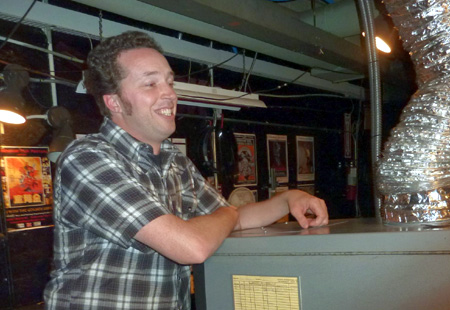 Dan
in the Baker booth behind Serial Number 915. Dan
in the Baker booth behind Serial Number 915.Those of us in the Portland, Oregon metropolitan area have an embarrassment of riches in regards to the world of film. We have a number of brew pub cinemas, thanks to the McMenamins' chain, the Laurelhurst theatre, and the Academy theatre. There is boutique, high-end faire, with the likes of Cinetopia and the Living Room Theatres. Repertory cinemas, like the Cinema 21, which has been running foreign, classic and independent titles for decades. For fans of grindhouse, music, documentaries and "Rocky Horror Picture Show" we have the Clinton. Additionally, there is Portland State University student run 35mm theatre, the 5th Avenue Cinema. Finally, there are several local and national chain theatres that offer everything from obscure imports, Imax and the latest franchise movies, like the Marvel superheroes. Not one theatre, however, has run 70mm since the Robert Harris restoration of Alfred Hitchcock's "Vertigo" in 1996. One of our finest jewels in the film crown of Portland is about to change that: The Hollywood Theatre. |
More in 70mm reading: Help the Hollywood Theatre Bring 70mm Film Back to Portland! Internet link: The Hollywood Theatre American Cinema Equipment Northwest Projection |
 2006
and the old marquee with "Cinerama Adventure" playing. 2006
and the old marquee with "Cinerama Adventure" playing. Via an introduction by Hollywood Theatre Executive Director Doug Whyte, I was placed in contact with their projectionist and Head Programmer Dan Halsted, who is the originator of the 70mm project. Dan has been a projectionist in the Portland for over 10 years, has served as the technical director at the Hollywood and moved into programming for the theatre. He first started doing his own events by presenting rare 35mm prints of obscure exploitation films, and eventually became the head programmer. He initiated the 70mm project and it is virtually his entire doing. Like many an old movie palace, the Hollywood Theatre suffered from the indignity of having its balcony converted into 2 small auditoria. This occurred in the 1970's, the decade of multiplex expansion and conversion. In many ways, this has turned out for the better for the non-profit today, in that they can do simultaneous targeted programming of niche media, while still providing the orchestra floor for larger audiences with an expansive film experience on a large screen. |
|
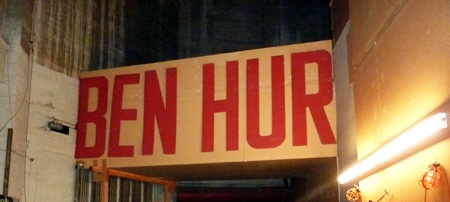 Theatre
storage. Original sign for Ben-Hur engagement at Hollywood after it finished
its roadshow run at the Music Box. Theatre
storage. Original sign for Ben-Hur engagement at Hollywood after it finished
its roadshow run at the Music Box.It provides for a more efficient use of the property and better service to the communities that make use of it. However, because of changing times and markets over the decades that carved the theatre up into 3 rooms, the 70mm system at the theatre has almost all but disappeared. Previous owners discarded, sold off or repurposed at other sites most of the equipment required for 70mm. Just the vestiges of it remained for Dan to work with. The theatre was cannibalized and this has become part of the challenge Dan has faced in resurrecting large format showings. |
|
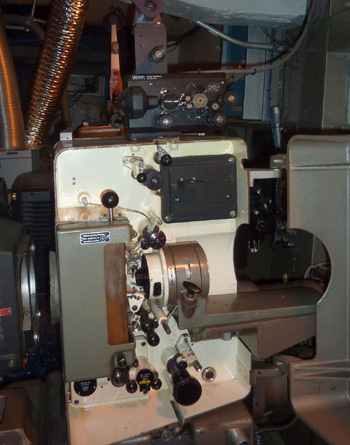 DP70
#915, with #913 behind it. DP70
#915, with #913 behind it.Because of changes to the Regal Cinemas chain is making in the Portland Area to several of its theatres, Dan and the theatre have had access to equipment donations that have help with retrofitting and upgrading of the theatre. Regal converted one of their Lloyd Cinema auditoriums to an upscale Imax venue. The seats that were removed were only a few years old and in perfect condition, so were used to replace the tired, weak spring ones at the Hollywood. Also, and most significantly, Regal closed its subterranean art house venue, the Broadway Metro 4. This allowed the theatre to reclaim the Norelco AA that was removed from the Hollywood when it was made a triplex and plattered. Now the theatre has 35mm and 70mm change over capability again along with a platter system. Dan was also able to grab a number of the 35mm heads and accessories, since sadly, most of that equipment is not showing up in the used market, but is sent directly to landfills (Oh, the humanity). This brings up an important point: those who can collect equipment before too much more is irretrievably lost would be doing the film world a great service by collecting whatever equipment they can. Furthermore, if you have knowledge of film equipment slated for removal, getting word out to the collector and exhibitor community is important. It's achingly obvious that in this digital age we will never see the likes of the this equipment manufactured again (except by 3D printers, perhaps). |
|
 Parts
to complete the restoration. Parts
to complete the restoration.The mag head assemblies from both Norelco projectors were missing, but he has now on site replacements for both machines, in addition to getting lenses, sprockets, film gates, etc. Also, dts units are being acquired for the machines since newer 70mm prints are distributed without mag sound. They are also in the process getting a Dolby CP200 Processor. The current 3 screen speakers will need a Left Extra and Right Extra which are easily obtained for the full Todd-AO spread. Due to their extreme rarity, 70mm anamorphic lenses have not been procured. Dan has had terrific help from a film collectors, American Cinema Equipment and from Joel Miller at Northwest Projection to make all this come to fruition. |
|
 Dan
Halsted with the Baker booth that houses the 2 Norelco AA's plus their
digital projector. Dan
Halsted with the Baker booth that houses the 2 Norelco AA's plus their
digital projector.The goal is to be up and running January 2015 with "Vertigo". Then, present another program about every 6 months thereafter. The theatre is a non-profit and shipping cost for these titles is very expensive. By showing the films on a twice yearly basis, it will keep the event special while managing good stewardship of the operational funds. In addition to running classic titles, there is also great excitement about the forthcoming new releases in 70mm. "Interstellar" is being release in 35mm and 70mm and Quentin Tarantino is planning a 70mm release for "The Hateful Eight". The Hollywood Theatre project will just miss the release of "Interstellar" (they will run it in 35mm, however), but their 70mm capability should up in time for Tarantino's film. |
|
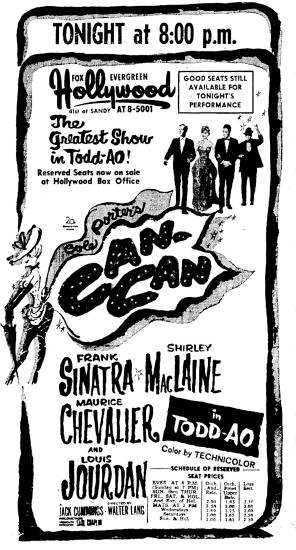 The Hollywood has run 70mm in the past starting with the Todd AO show
"Can Can", starting June 29, 1960. (This is based on gleaning sketchy
info from past issues of the local daily newspaper, "The Oregonian"). Its
widescreen past also included the Portland run of "Windjammer" in
Cinemiracle which began on May
8, 1959. 3 strip Cinerama came to
theatre on November 22, 1961 and 70mm Cinerama began with "It's A Mad,
Mad, Mad, Mad World" on December 19, 1963. Over the years, when Cinerama
product was unavailable, other 70mm features like "Far From The Madding
Crowd" or 35mm features like "To Sir With Love" took up
residency. The Hollywood has run 70mm in the past starting with the Todd AO show
"Can Can", starting June 29, 1960. (This is based on gleaning sketchy
info from past issues of the local daily newspaper, "The Oregonian"). Its
widescreen past also included the Portland run of "Windjammer" in
Cinemiracle which began on May
8, 1959. 3 strip Cinerama came to
theatre on November 22, 1961 and 70mm Cinerama began with "It's A Mad,
Mad, Mad, Mad World" on December 19, 1963. Over the years, when Cinerama
product was unavailable, other 70mm features like "Far From The Madding
Crowd" or 35mm features like "To Sir With Love" took up
residency. It is quite exciting to look a revival of this nature in the age of bits and automation as this supremely conceived prestige format of the past gets a chance to once again show its strengths as an exhibition medium. Some of the 20th century's masterworks were created and/or presented in this format. It would be a shame if it were lost to history. A big thank you to Dan for his giving me a comprehensive tour of the cinema and taking precious time from his day to show me the facility. Grateful acknowledgment goes out to Michael Coate and other contributors of in70mm.com for their published research herein. |
|
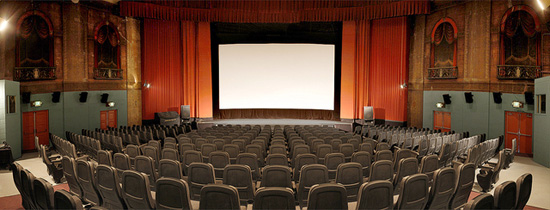 Photo
from
cinematreasures.org. If you look at the extreme left and right of this
picture you will see the Able and Charlie booths still standing from the 3
strip days. No projectors are contained within. The unknown photographer of
this picture did a fabulous job of capturing the upgrades to seating and
sound while showing the screen frame from the Cinerama runs and the original
artwork on the walls that had been hidden by the red draping for decades. Photo
from
cinematreasures.org. If you look at the extreme left and right of this
picture you will see the Able and Charlie booths still standing from the 3
strip days. No projectors are contained within. The unknown photographer of
this picture did a fabulous job of capturing the upgrades to seating and
sound while showing the screen frame from the Cinerama runs and the original
artwork on the walls that had been hidden by the red draping for decades. |
|
| Go: back - top - back issues - news index Updated 22-01-25 |
